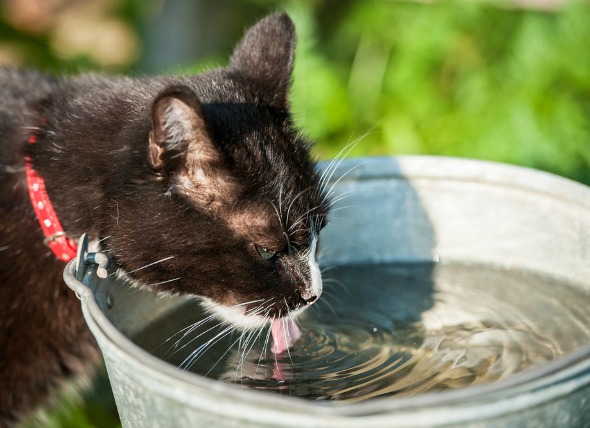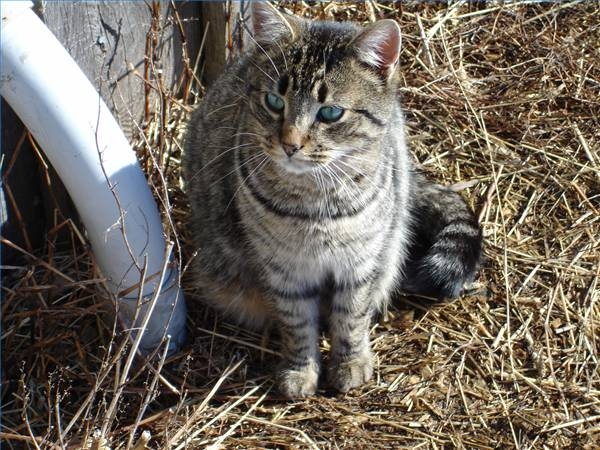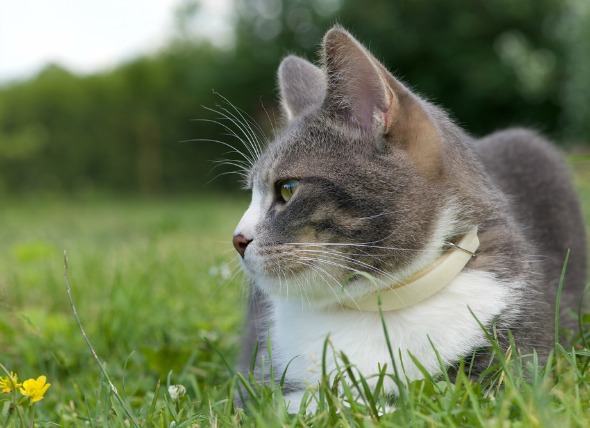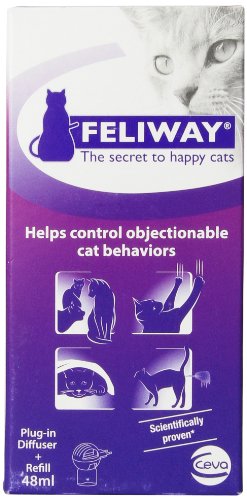
It's every pet owners worse nightmare, a sick older pet. No pet owner likes knowing their pet is not feeling well or is not functioning right. Even once you get your pet to the Vet there are often days between the animal getting sick and the diagnosis. Sometimes you have to make multiple visits to the vet to get the right diagnosis. It's stressful for everyone involved. And it's not about the extra money, it's not the extra needed time for food preparation or to give meds – they are family to us more often than not and my cat is no exception.
At sixteen years of age my cat was starting to finally show his age. He was slowing down, napping more and lying around awake. He played less but was still interested in what was going on around him. His fur was soft and his eyes were shiny, he still ate even if it was a little less, his fat was coming off and he got a little skinnier ... it was all just part of the natural aging process, I told myself.
At first he started to regurgitate his food (dry) off and on over the next few months. I started to watch him a little more closely, but despite that and all the above, he seemed healthy and happy, was still eating and drinking.
The weight loss was slow but steady. I switched him from dry foods to wet foods for sensitive stomachs, this resulted in him appearing to be better. Then out of nowhere and within days the vomiting began and the diarrhea started, he lost interest in food completely, the weight loss was speeding up, he was listless, always tired and looking miserable and depressed.
Seeing it wasn't going to pass, I made an appointment with a veterinarian.
On the morning he was to go to the vet, he started to show some tremors and was quite anaemic looking. He could barely resist against the indignities of having to drive in a car. I was getting steadily more worried. Exam, blood and some other tests were taken and it came back that Boscoe, my cat, has Addison's Disease or hypoadrenocorticism.
I had never heard of it, I had no idea what it was and all I was told was that it meant his adrenal glands were not working properly. He was given medication and I was sent home with advice on how to care for him. I turned to the internet for more information and as a way to get my many questions answered.
For close to fifteen years Boscoe rarely ever caused me any concern about his health, I was incredibly lucky that he was a healthy cat for the bulk of his life. But how did this condition come so suddenly, was it something I did, is there an underlying cause for this, what is the treatment and what does it do. More importantly I wanted to know what kind of quality of life as well as quantity of life I could expect from my cat.
Hypoadrenocorticism, which is also known by a number of terms such as adrenal insufficiency, Addison’s Disease and the Great Imitator. It's a rare disease in cats, but still usually quite treatable.
Hypoadrenocorticism is a disorder of the adrenal glands in which an insufficient amount (if any) of adrenal hormones (that are essential to life) are produced. The consequences of adrenal gland failure are severe and when left untreated Addison's Disease can lead to death.
Hypoadrenocorticism has two subsets or types ... primary and secondary. Primary is the naturally occurring one (rare) and secondary is due to outside factors (more common).

Because the naturally occurring type of this disease is very rare for cats, most are diagnosed as having secondary Addison's disease, or iatrogenic hypoadrenocorticism. Secondary hypoadrenocorticism is caused by the long term use of steroids mainly for behavioural or dermatological reasons, the pituitary gland and not adrenal is the gland that is affected[1].
Boscoe has never been on steroids and he suffers from the rarer form of naturally occurring Addison's Disease or primary hypoadrenocorticism. Primary hypoadrenocorticism is a dysfunction in the adrenal gland itself caused by autoimmune disorders or atrophy, but many also say that the specific cause may never be known in your cat, just that they suffer from it.
It's known as the Great Imitator because the symptoms for this disease are vague and general - it's related to many and more common conditions found in cats. It tends to come and go quickly and often it takes a number of visits to the vet – as well as different diagnosis - before Addison's Disease is suspect. Some of the conditions that this disease mimics and that vets tend to check for and treat first are: gastrointestinal issues such as foreign bodies and infections, inflammatory bowel disease or IBD, some cancers, kidney (renal) diseases, pancreatitis, urinary blockages and diseases that cause hypercalcemia.[2]
I was very lucky when it came to Boscoes diagnosis because the vet he went to was familiar with Addison's Disease and has a few patients that do suffer from it and he immediately recognized Boscoes (more advanced) symptoms and blood work. This could have cost me thousands to diagnose and fix instead of the hundreds it did cost me ... which was worth spending, for the record.
The adrenal glands are located just in front of the kidney (renal means kidney). The glands are small triangular-shaped glands with its centre called the medulla and the outer area called the cortex, both areas produce hormones[3]. These hormones act as blood stream, travelling chemical messengers that enable the bodily processes to work properly. Adrenal gland hormones are essential to life.

The adrenal glands produce four main hormones:[3]
Cats with Addison's Disease are unable to produce one or two of these hormones namely Cortisol and Aldosterone hormones, both of which are secreted from the adrenal cortex or the outer layer of the adrenal gland, these hormones are known as – mineralocorticoid and corticosteroids[4]. Mineralocorticoid such as Aldosterone influence the electrolytes sodium and potassium. Corticosteroid hormones are needed to adapt to stressful situations and without these hormones, even small stresses could lead to physiologic disaster.[5]
It is not uncommon for pets (and their owners) to go through a couple of diagnosis before arriving at Addison's Disease. More often though many pets arrive in a state of crisis that requires medical intervention, in these cases it is easier to 'see' and diagnose as Addison's Disease. A pets medical history, clinical signs and certain laboratory abnormalities, such as a lack of cortisol response to ACTH will confirm for Addison's disease.

The symptoms and cats medical history will generally show which type of hypoadrenocorticism your pet is suffering from as the symptoms are different. If your pet is in adrenal crisis or Addison's crisis you will have to stabilize him first before beginning any type of treatment. In Boscoe's case this meant the use of Cerenia, an anti-vomitting pill and he received a shot of antibiotics called Covenia.
Treatment should be individualized for each pet and some treatment may require hospitalization in extreme cases. The most important aspect of treatment is replacing the missing hormones.
One way to do this is with oral fludrocortisone acetate or its trade name of Florinef[6]. It's considered a pricey medicine, though I found it not that bad price wise, but generally you need only the one medicine and not a few. Naturally, your pet should be monitored to see if the medication is doing what it's suppose to be doing at the level it needs to be doing it at. Blood tests are more frequent in the beginning of the treatment and gradually lowers to only two to four visits a year ... even if your pet seems 'just like before – healthy'.
This is the medicine Boscoe is on, oral fludrocortisone acetate, and it has been about 4 days and he seems to be improving, slowly, but improving. The veterinarian say that this particular medicine can take three to five days before showing improvements (in cats; dogs seem to show improvement quicker).
Another way to treat this condition is with an injectable medication called DOCP (brand name Percorten-V). This treatment is given about every 25 days and you will have to go to the veterinarian to get them done. Electrolytes are measured before injections at first but testing can usually eventually be tapered to once or twice a year.[2]
Home and professional veterinary care is the way to achieve successful treatment. The bulk of care will be at home and it is important you follow a few rules[6]:
Remember that there is no preventive care for the naturally occurring forms of this condition (primary). The only preventive care for Addison's Disease is in the secondary type of hypoadrenocorticism, which is the one caused by steroid use.

 Increased Urination and Thirst in Cats
Polydipsia and Polyuria in Cats
Polyuria refers t
Increased Urination and Thirst in Cats
Polydipsia and Polyuria in Cats
Polyuria refers t
 How Do Cats Communicate?
How Do Cats Communicate?
How Do Cats C
How Do Cats Communicate?
How Do Cats Communicate?
How Do Cats C
 Inability to Urinate in Cats
Functional Urinary Retention in Cats
Urinary rete
Inability to Urinate in Cats
Functional Urinary Retention in Cats
Urinary rete
 Feliway Review: Useful Tool Or Scam?
Feliway Spray and Diffuser
Feliway Review: Useful Tool Or Scam?
Feliway Spray and Diffuser
 How to Repel Cats With Citrus
How to Repel Cats With Citrus
How to R
How to Repel Cats With Citrus
How to Repel Cats With Citrus
How to R
Copyright © 2005-2016 Pet Information All Rights Reserved
Contact us: www162date@outlook.com